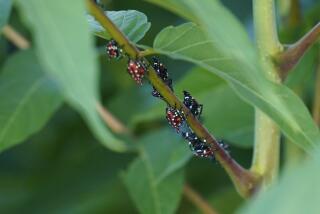Mission Supporters Try to Lure Swallows’ Scouts : Migration: Activists have prepared a banquet of bugs and mud for nest-building in hopes birds will return.
- Share via
SAN JUAN CAPISTRANO — The effort to draw the migratory swallows back to their famed stopover at Mission San Juan Capistrano began Monday with the release of thousands of bugs to attract them.
Wildlife activists and mission supporters say dwindling numbers of the swallows are showing up for their annual visit to the mission, a springtime rite that for decades has been an international tourist attraction. The reason for the decline is that many of the longstanding mud nests were torn down during state-mandated work to make the 219-year-old mission earthquake safe six years ago.
The bug release on Monday, the first in a series planned over the coming months, targets the “scout” birds that start appearing now as leaders of the swallows’ northward migration from South America. The celebration marking the swallows’ annual visit is set for March 19.
“They will go to areas where the birds have previously gone that were good nesting opportunities, especially good eating opportunities,” said Linda McLeod Evans, executive director of the Laguna Niguel-based Pacific Wildlife Project. “It was important for us to attract the attention of the scouts.”
Activists sprinkled 3,000 live ladybugs and the larvae of 1,000 green lacewings around the mission’s gardens.
It didn’t take long for promising signs that the strategy just might work.
“We no sooner had finished sprinkling the lady beetles when we looked up and saw four swallows overhead. They swooped down where we sprinkled the beetles. . . . We think they’ve already spotted them.”
Evans said mission gardeners have tilled the soil and watered it so arriving swallows will have mud with which to build nests. In coming weeks, supporters will install clay replica nests, and more bug releases are planned until the swallows begin heading back home in September, she said.
The birds’ storied ties to the area date to the 1700s, when Father Junipero Serra was said to have welcomed them each spring. The migratory visit has become a major tourist event watched the world over.
More to Read
Sign up for Essential California
The most important California stories and recommendations in your inbox every morning.
You may occasionally receive promotional content from the Los Angeles Times.













